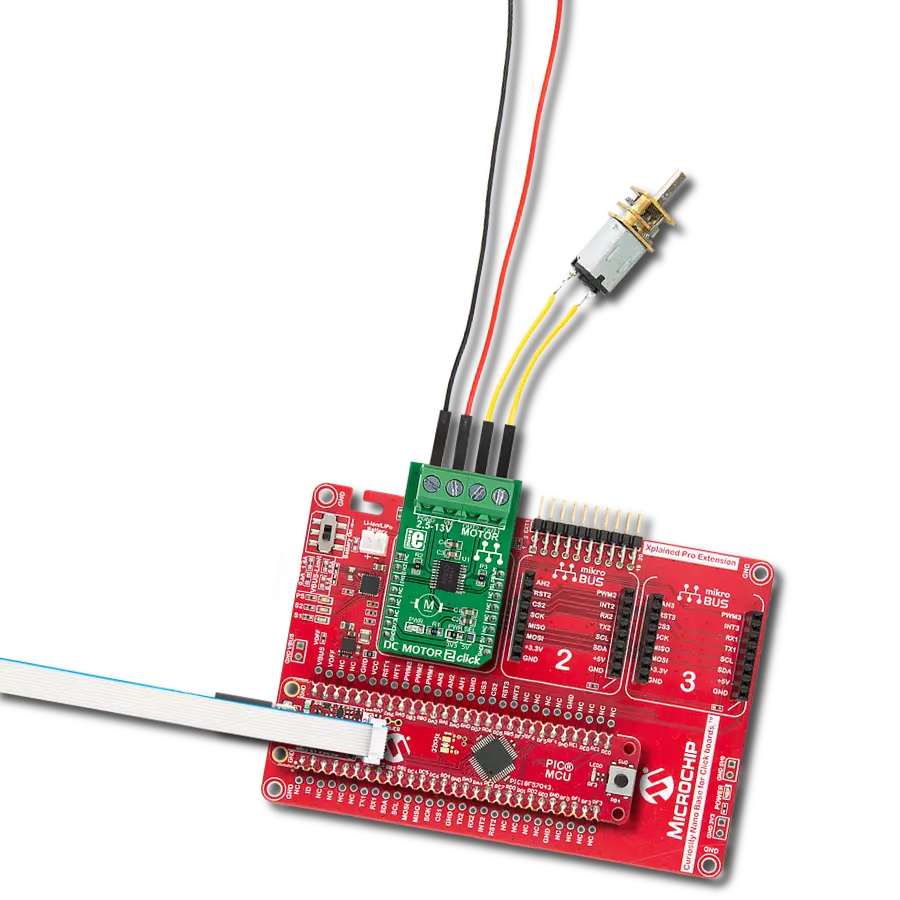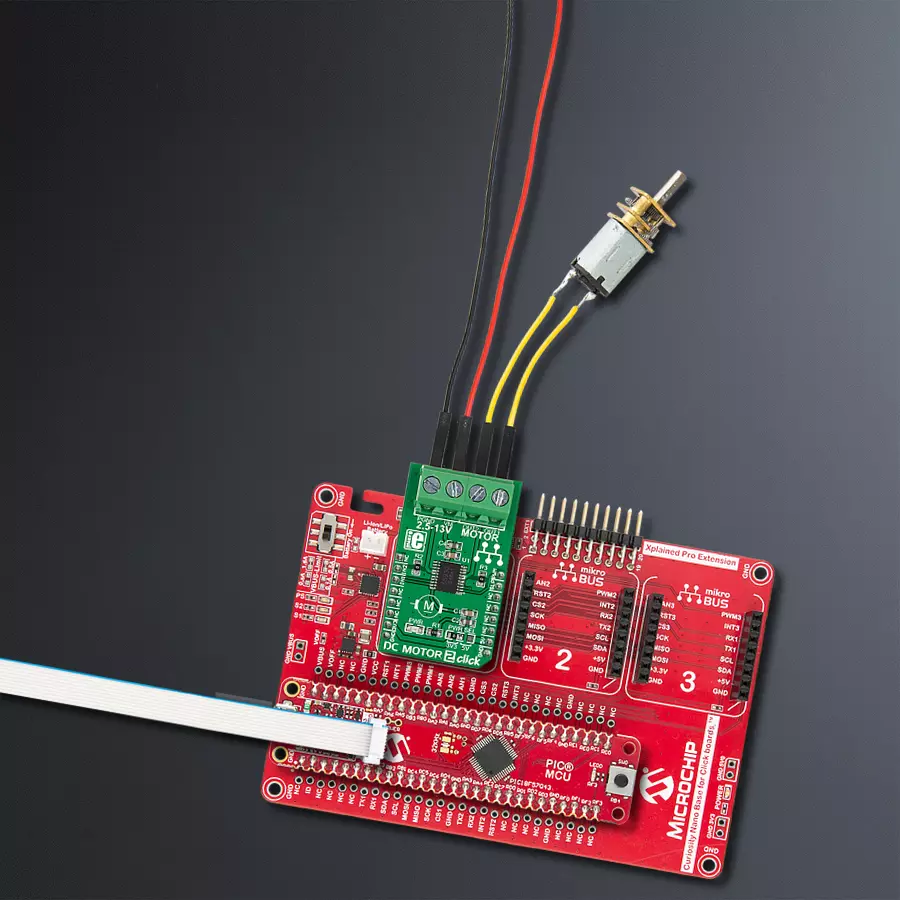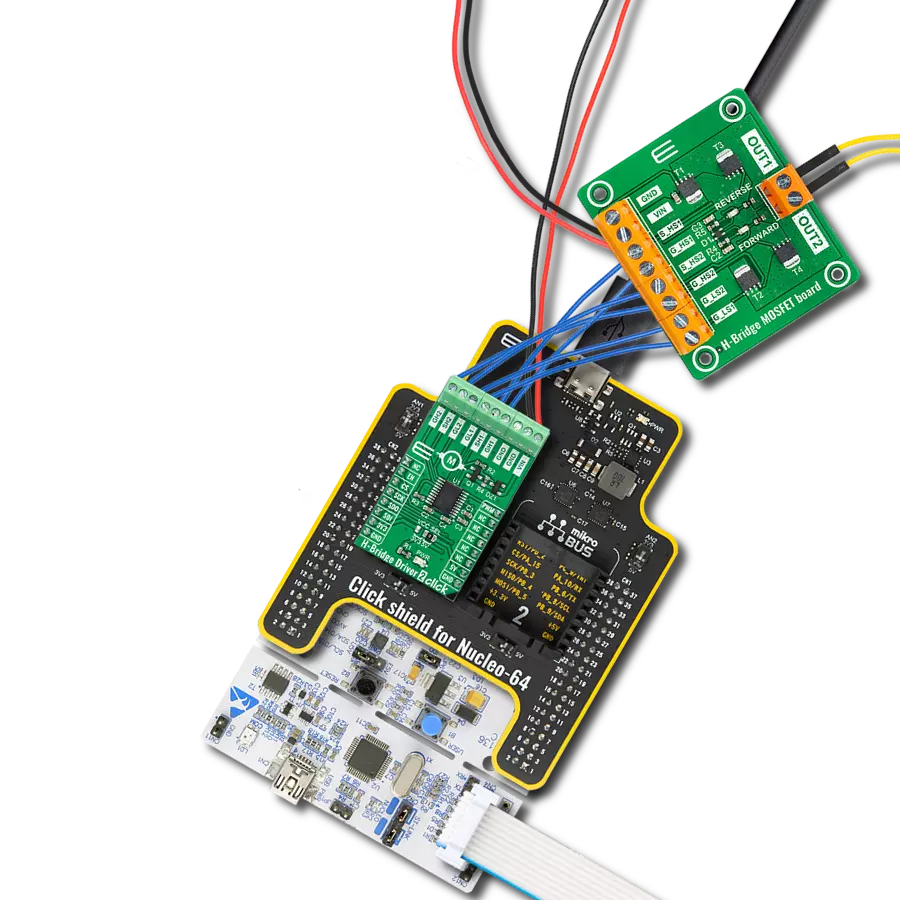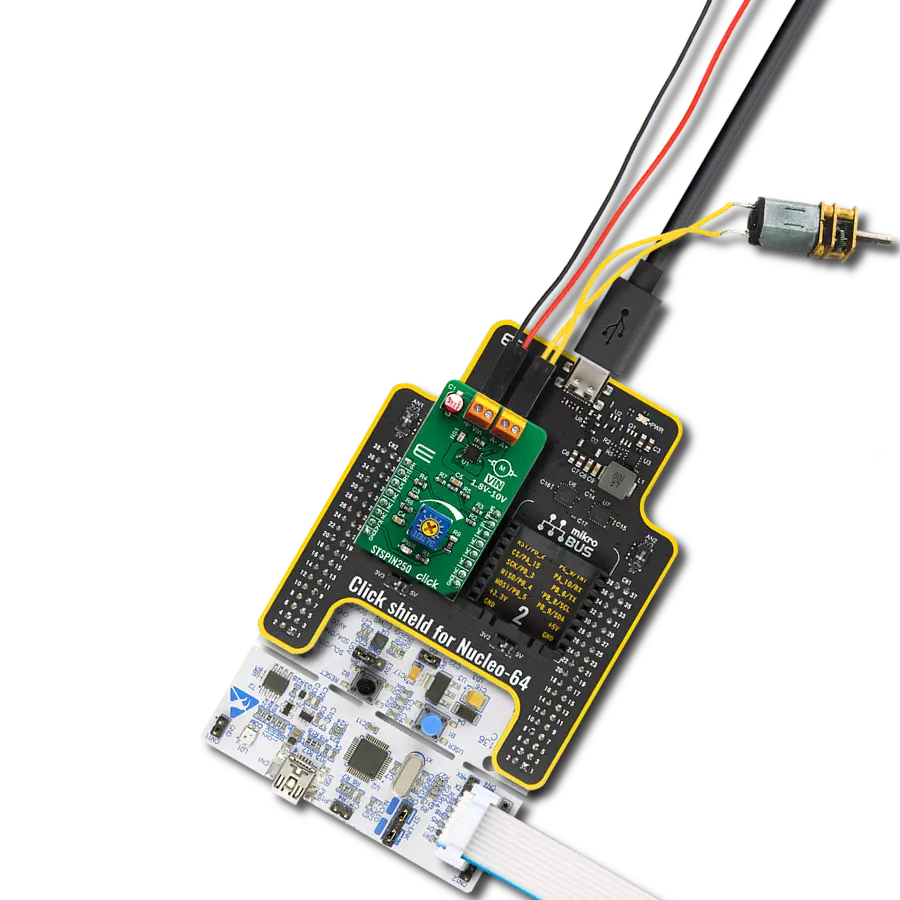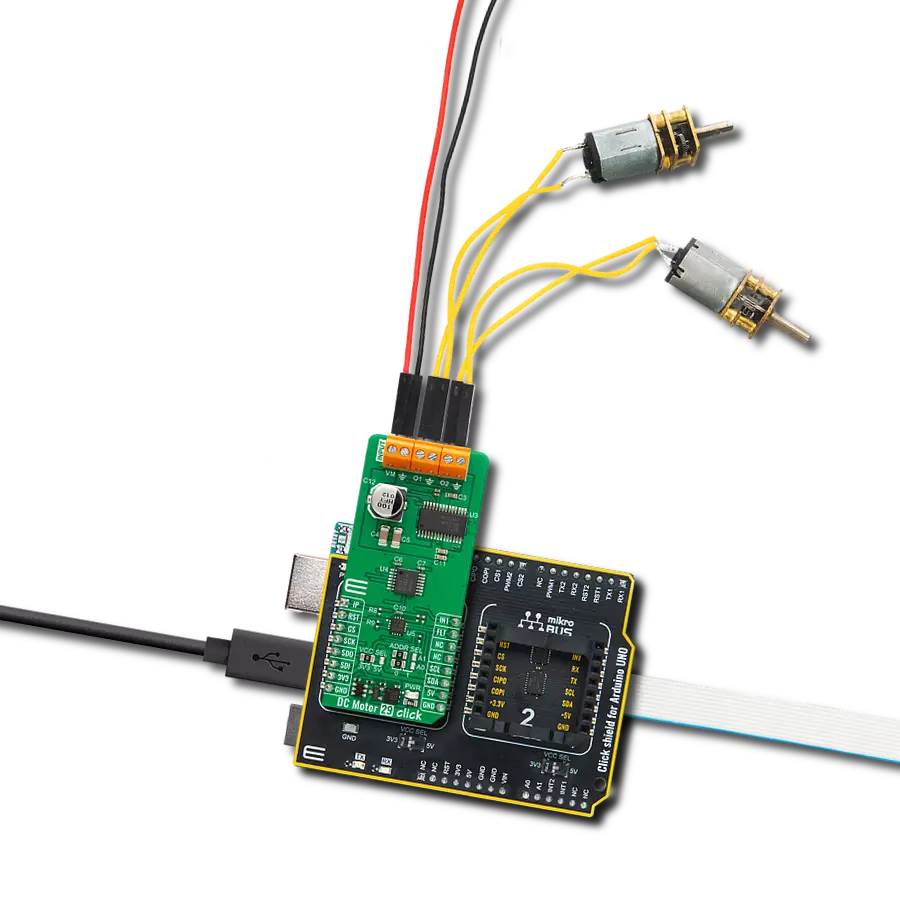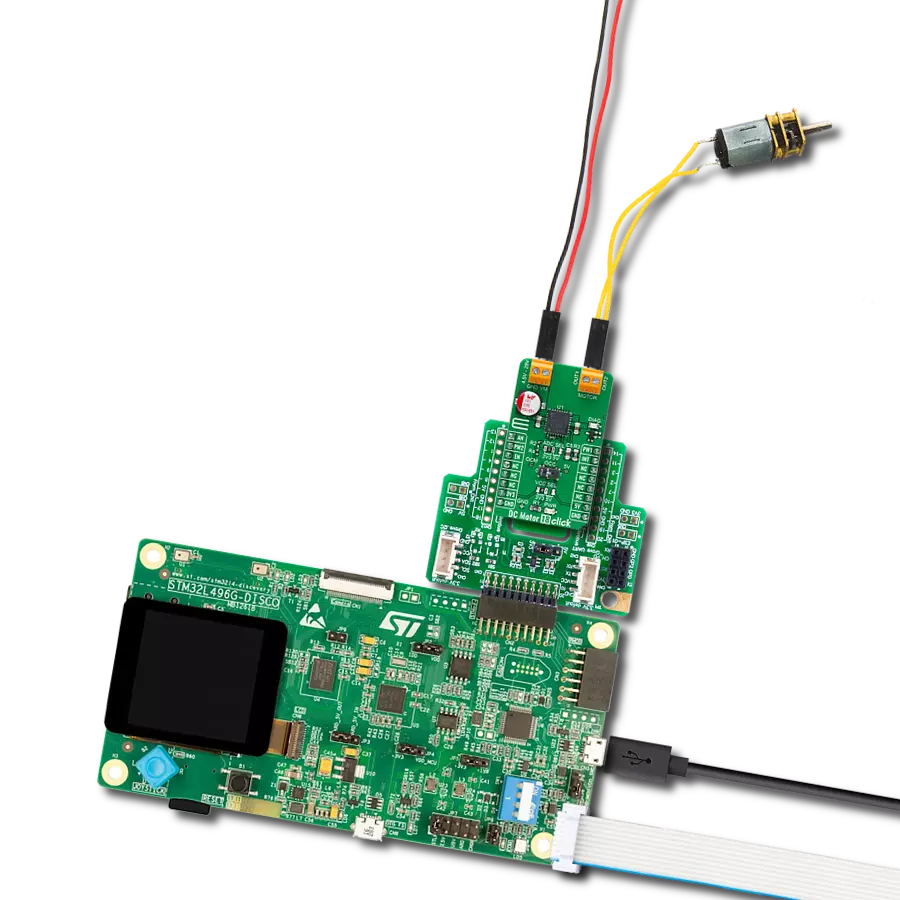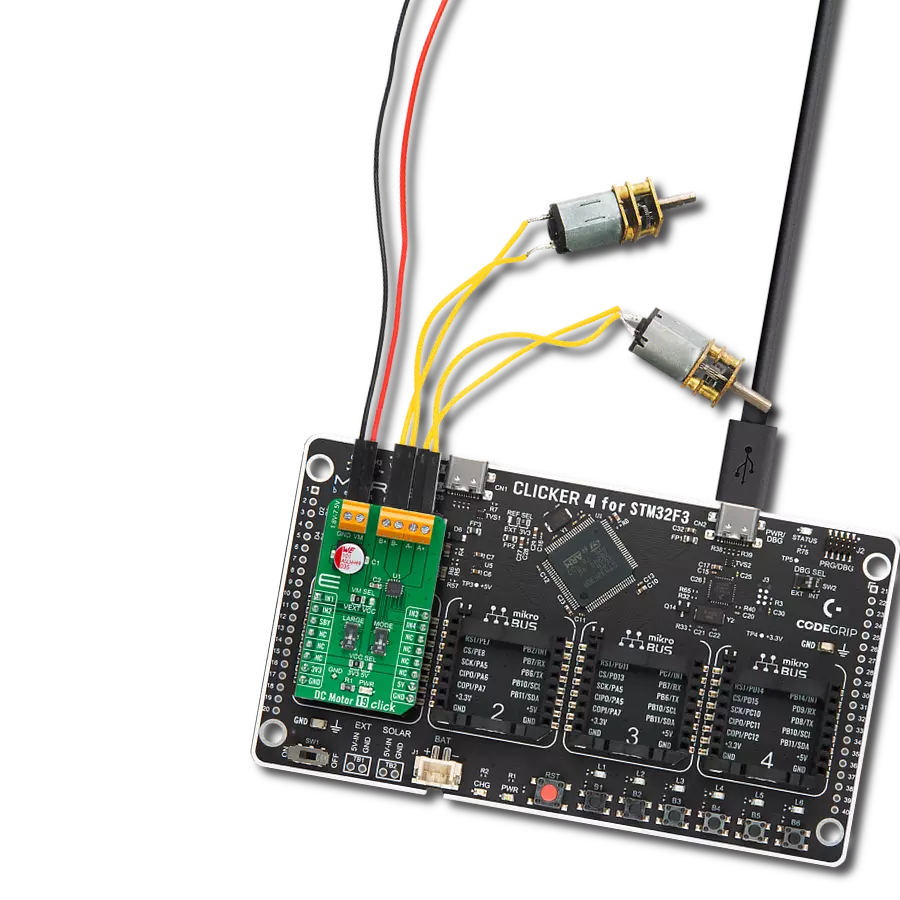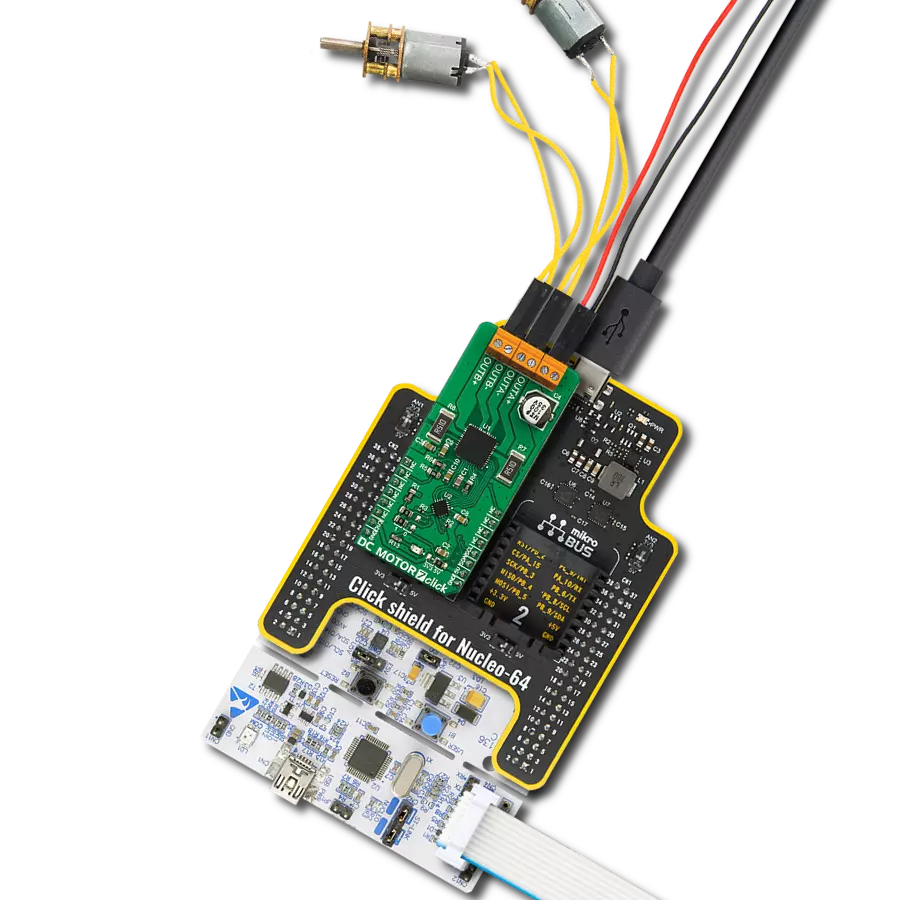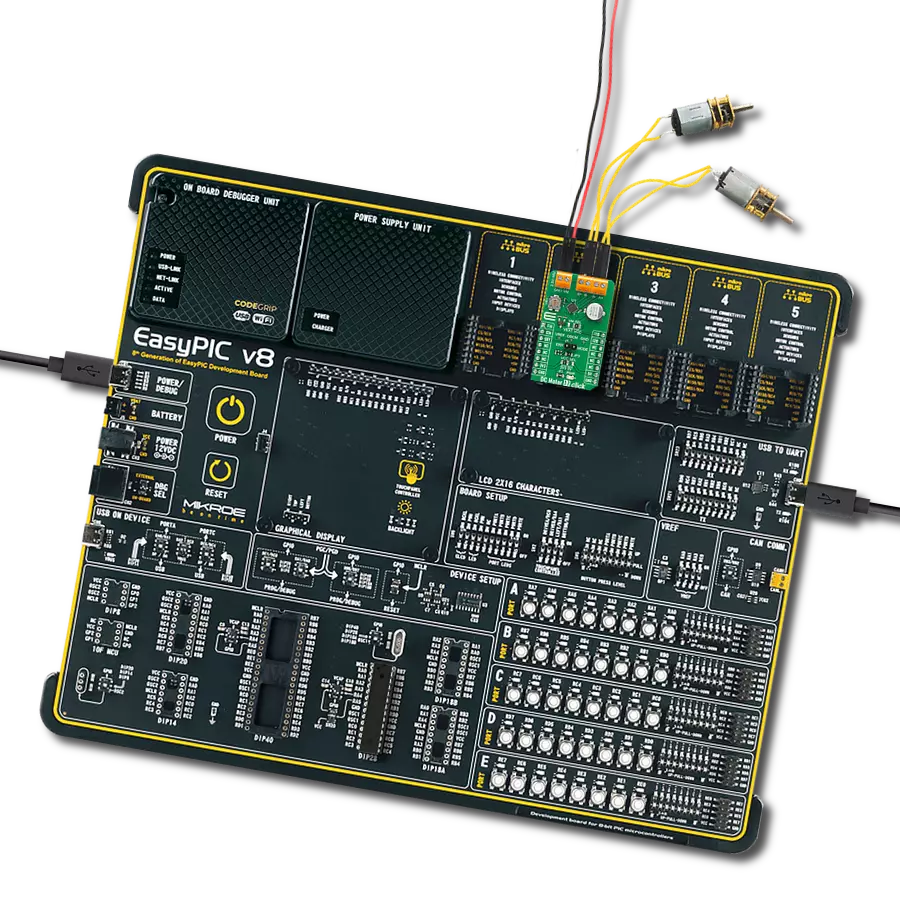Upgrade your engineering prowess, maximize efficiency, and unlock the "full-bridge" potential of your motors
A
A
Hardware Overview
How does it work?
DC MOTOR 2 Click is based on the TB6593FNG, full-bridge brushed DC motor driver from Toshiba Semiconductor. The TB6593FNG comes in a configuration with an output transistor in LD MOS structure with low on-resistance (0.35Ω typical with 5V power supply). It has a wide operating voltage range with an output current capacity of 1A maximum and control functions, including motor-related and built-in protection circuits such as thermal shutdown and low voltage detecting. This Click board™ is a PWM-controlled type with the ability for motor control through several pins of the mikroBUS™ socket. The PWM signal of the mikroBUS™ socket drives the motor while the IN1
and IN2 pins, routed on the CS and RST pins of the mikroBUS™ socket, provide binary direction signals that set the direction of the motor (clockwise or counterclockwise) or apply stop or short brake functions. Stop mode cuts off the power supply, so the motor continues spinning until it runs out of momentum, while a short break brings it to an abrupt stop. Alongside the PWM pin from the mikroBUS™ socket, used to drive a DC motor, this Click board™ also has a Standby pin labeled as SLP and routed to the INT pin of the mikroBUS™ socket to optimize power consumption used for power saving purposes. DC MOTOR 2 Click supports an external power supply
for the TB6593FNG, which can be connected to the input terminal labeled as VM and should be within the range of 2.5V to 13V, while the DC motor coils can be connected to the terminals labeled as OUT1 and OUT2. This Click board™ can operate with both 3.3V and 5V logic voltage levels selected via the PWR SEL jumper. This way, it is allowed for both 3.3V and 5V capable MCUs to use the communication lines properly. However, the Click board™ comes equipped with a library containing easy-to-use functions and an example code that can be used, as a reference, for further development.
Features overview
Development board
PIC18F57Q43 Curiosity Nano evaluation kit is a cutting-edge hardware platform designed to evaluate microcontrollers within the PIC18-Q43 family. Central to its design is the inclusion of the powerful PIC18F57Q43 microcontroller (MCU), offering advanced functionalities and robust performance. Key features of this evaluation kit include a yellow user LED and a responsive
mechanical user switch, providing seamless interaction and testing. The provision for a 32.768kHz crystal footprint ensures precision timing capabilities. With an onboard debugger boasting a green power and status LED, programming and debugging become intuitive and efficient. Further enhancing its utility is the Virtual serial port (CDC) and a debug GPIO channel (DGI
GPIO), offering extensive connectivity options. Powered via USB, this kit boasts an adjustable target voltage feature facilitated by the MIC5353 LDO regulator, ensuring stable operation with an output voltage ranging from 1.8V to 5.1V, with a maximum output current of 500mA, subject to ambient temperature and voltage constraints.
Microcontroller Overview
MCU Card / MCU
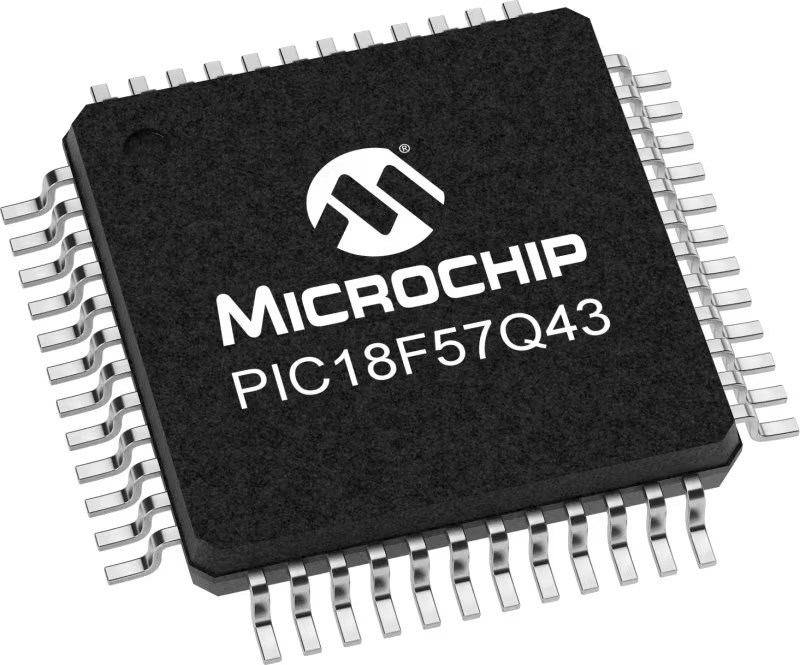
Architecture
PIC
MCU Memory (KB)
128
Silicon Vendor
Microchip
Pin count
48
RAM (Bytes)
8196
You complete me!
Accessories
Curiosity Nano Base for Click boards is a versatile hardware extension platform created to streamline the integration between Curiosity Nano kits and extension boards, tailored explicitly for the mikroBUS™-standardized Click boards and Xplained Pro extension boards. This innovative base board (shield) offers seamless connectivity and expansion possibilities, simplifying experimentation and development. Key features include USB power compatibility from the Curiosity Nano kit, alongside an alternative external power input option for enhanced flexibility. The onboard Li-Ion/LiPo charger and management circuit ensure smooth operation for battery-powered applications, simplifying usage and management. Moreover, the base incorporates a fixed 3.3V PSU dedicated to target and mikroBUS™ power rails, alongside a fixed 5.0V boost converter catering to 5V power rails of mikroBUS™ sockets, providing stable power delivery for various connected devices.
DC Gear Motor - 430RPM (3-6V) represents an all-in-one combination of a motor and gearbox, where the addition of gear leads to a reduction of motor speed while increasing the torque output. This gear motor has a spur gearbox, making it a highly reliable solution for applications with lower torque and speed requirements. The most critical parameters for gear motors are speed, torque, and efficiency, which are, in this case, 520RPM with no load and 430RPM at maximum efficiency, alongside a current of 60mA and a torque of 50g.cm. Rated for a 3-6V operational voltage range and clockwise/counterclockwise rotation direction, this motor represents an excellent solution for many functions initially performed by brushed DC motors in robotics, medical equipment, electric door locks, and much more.
Used MCU Pins
mikroBUS™ mapper
Take a closer look
Click board™ Schematic

Step by step
Project assembly
Track your results in real time
Application Output
1. Application Output - In Debug mode, the 'Application Output' window enables real-time data monitoring, offering direct insight into execution results. Ensure proper data display by configuring the environment correctly using the provided tutorial.

2. UART Terminal - Use the UART Terminal to monitor data transmission via a USB to UART converter, allowing direct communication between the Click board™ and your development system. Configure the baud rate and other serial settings according to your project's requirements to ensure proper functionality. For step-by-step setup instructions, refer to the provided tutorial.

3. Plot Output - The Plot feature offers a powerful way to visualize real-time sensor data, enabling trend analysis, debugging, and comparison of multiple data points. To set it up correctly, follow the provided tutorial, which includes a step-by-step example of using the Plot feature to display Click board™ readings. To use the Plot feature in your code, use the function: plot(*insert_graph_name*, variable_name);. This is a general format, and it is up to the user to replace 'insert_graph_name' with the actual graph name and 'variable_name' with the parameter to be displayed.

Software Support
Library Description
This library contains API for DC MOTOR 2 Click driver.
Key functions:
dcmotor2_spin_counter_clockwise- This function sets the IN1/IN2 pins to 0/1 and makes the motor spin counter clockwise.dcmotor2_spin_clockwise- This function sets the IN1/IN2 pins to 1/0 and makes the motor spin clockwise.dcmotor2_pull_brake- This function sets the IN1/IN2 pins to 1/1 and forces the motor to break.dcmotor2_stop_motor- This function sets the IN1/IN2 pins to 0/0 and stops the motor completely.
Open Source
Code example
The complete application code and a ready-to-use project are available through the NECTO Studio Package Manager for direct installation in the NECTO Studio. The application code can also be found on the MIKROE GitHub account.
/*!
* \file
* \brief DcMotor2 Click example
*
* # Description
* This library contains API for the DC Motor 2 Click driver.
* This example showcases how to initialize and use the DC Motor 2 Click. The Click contains a
* Driver IC for DC motors which can spin the motor clockwise, counter-clockwise, break it and
* completely stop the motor. The example needs a DC motor and a power supply in order to work.
*
* The demo application is composed of two sections :
*
* ## Application Init
* This function initializes and configures the logger and Click modules.
*
* ## Application Task
* This is an example that demonstrates the use of the DC Motor 2 Click board.
* DC Motor 2 Click communicates with register via PWM interface.
* It shows moving in the Clockwise direction from slow to fast speed
* and from fast to slow speed, then rotating Counter Clockwise,
* Results are being sent to the Usart Terminal where you can track their changes.
*
* \author Nikola Peric
*
*/
// ------------------------------------------------------------------- INCLUDES
#include "board.h"
#include "log.h"
#include "dcmotor2.h"
// ------------------------------------------------------------------ VARIABLES
static dcmotor2_t dcmotor2;
static log_t logger;
uint8_t dcmotor_direction = 1;
// ------------------------------------------------------ APPLICATION FUNCTIONS
void application_init ( )
{
log_cfg_t log_cfg;
dcmotor2_cfg_t cfg;
/**
* Logger initialization.
* Default baud rate: 115200
* Default log level: LOG_LEVEL_DEBUG
* @note If USB_UART_RX and USB_UART_TX
* are defined as HAL_PIN_NC, you will
* need to define them manually for log to work.
* See @b LOG_MAP_USB_UART macro definition for detailed explanation.
*/
LOG_MAP_USB_UART( log_cfg );
log_init( &logger, &log_cfg );
log_info( &logger, "---- Application Init ----" );
Delay_ms ( 100 );
// Click initialization.
dcmotor2_cfg_setup( &cfg );
DCMOTOR2_MAP_MIKROBUS( cfg, MIKROBUS_1 );
Delay_ms ( 100 );
dcmotor2_init( &dcmotor2, &cfg );
dcmotor2_pwm_start( &dcmotor2 );
Delay_ms ( 1000 );
log_info( &logger, "---- Application Task ----" );
}
void application_task ( )
{
static int8_t duty_cnt = 1;
static int8_t duty_inc = 1;
float duty = duty_cnt / 10.0;
if ( dcmotor_direction == 1 )
{
dcmotor2_pull_brake ( &dcmotor2 );
dcmotor2_spin_clockwise ( &dcmotor2 );
log_printf( &logger, "> CLOCKWISE <\r\n" );
dcmotor2_enable_motor ( &dcmotor2 );
}
else
{
dcmotor2_pull_brake ( &dcmotor2 );
dcmotor2_spin_counter_clockwise ( &dcmotor2 );
log_printf( &logger, "> COUNTER CLOCKWISE <\r\n" );
dcmotor2_enable_motor ( &dcmotor2 );
}
dcmotor2_set_duty_cycle ( &dcmotor2, duty );
log_printf( &logger, "> Duty: %d%%\r\n", ( uint16_t )( duty_cnt * 10 ) );
Delay_ms ( 500 );
if ( 10 == duty_cnt )
{
duty_inc = -1;
}
else if ( 0 == duty_cnt )
{
duty_inc = 1;
if ( dcmotor_direction == 1 )
{
dcmotor_direction = 0;
}
else if ( dcmotor_direction == 0 )
{
dcmotor_direction = 1;
}
}
duty_cnt += duty_inc;
}
int main ( void )
{
/* Do not remove this line or clock might not be set correctly. */
#ifdef PREINIT_SUPPORTED
preinit();
#endif
application_init( );
for ( ; ; )
{
application_task( );
}
return 0;
}
// ------------------------------------------------------------------------ END
Additional Support
Resources
Category:Brushed
